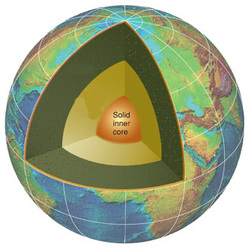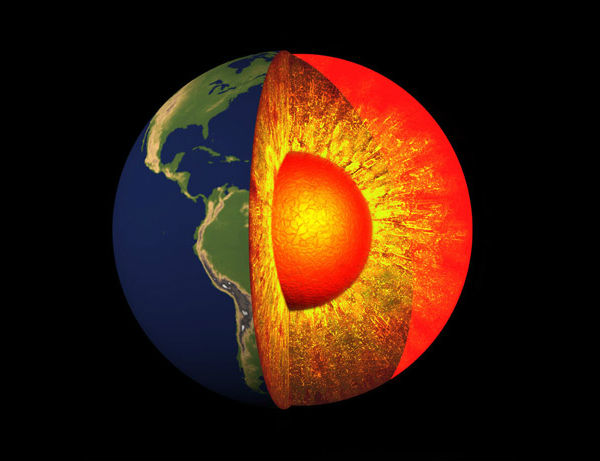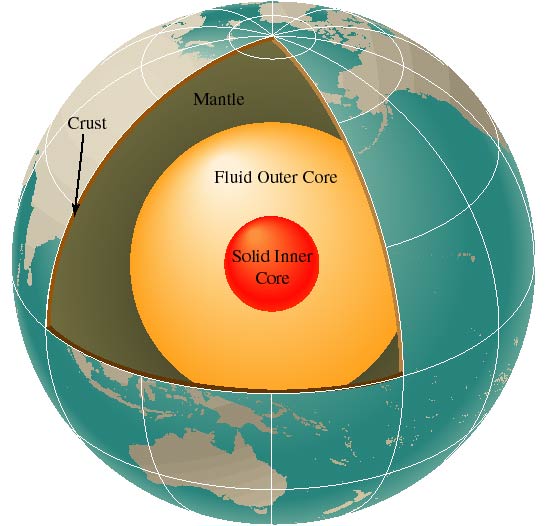Inner core
The Earth's core is the metallic central part of the earth. Its diameter of 6942 km is more than half as large as that of the entire planet. Although the Earth's core makes up only one-sixth of Erdvolumens, he wears due to its high density, with around one third of the total mass of the Earth at. Evaluations of seismic waves showed that the Earth's core consists of a liquid outer core and a solid inner core. In the outer core, the Earth's magnetic field is created.
History
In 1906 suspected the British geologist Richard Dixon Oldham based on its evaluation of run-time differences at P - waves and S- waves triggered by an earthquake that the earth has a core, and assumed that the core - mantle boundary of the earth's surface seen is about a factor 0.4 of the radius of the earth, roughly 2500 to 2600 km depth. 1914 calculated the German geophysicist Beno Gutenberg, the core - mantle boundary in 2900 km depth. The British mathematician and geophysicist Harold Jeffreys confirmed in 1939 in his calculations, the limit is 2898 ± 3 km. Today we know that the core - mantle boundary differs and is to be settled in the middle at 2900 km depth.
The Danish seismologist Inge Lehmann was already 1936, the border between the inner and outer core as a discontinuity in the propagation speed - the pattern of P waves indicated a strong distraction at this interface.
Structure and properties
The Earth's core has at a volume fraction of 16.2 % ( 17,548 · 1010 km3 ) to the total volume of the Earth has a mass fraction of 32.4 % ( 1.9354 x 1024 kg) of the total mass of the Earth.
The Earth's core is not a homogeneous structure. The seismic P- waves of an earthquake of 13.7 slow at the core- mantle boundary to 8.1 km / s and the velocity of S- waves is reduced from 7.3 km / s to 0 This leaves the inference that the outer core has to be liquid, since S- waves can not move in the fluids. Since the speed of the P-wave, however, increase again in the inner core, it is believed that the inner core is solid in nature.
Inner Earth's core
The inner core of the Earth begins at a depth of 5150 km and extends to the center of the earth. Despite the very high temperatures in the inner core, the ( ± 500 ° C) at the outer limit at 5957 ° C, there is this part of the Earth's core mostly of solid iron and minor amounts of nickel. It is believed that the iron -nickel alloy in the inner core composed of 80% iron and 20% nickel, wherein the density of the core from the boundary to the outer core of about 12.2 g/cm3 and the center rises to 12.6 to 13.0 g/cm3. The enormous pressure of 330 GPa could be an explanation for why the iron -nickel alloy of the inner core is not liquid tight and, as is the case in the outer core.
Outside Earth's core
The outer core of the Earth begins at a depth of 2900 km in the middle and ends at the border of the inner core at 5150 km. Its density is between about 9.9 g/cm3 and 12.2 g/cm3, which suggests that there are still in this part of other minerals and materials with a lower density. It is assumed that this oxygen, sulfur and silicon are mainly that may be involved along 10-15 % of the structure of the outer core of the earth. At temperatures between about 4200 ° C at the core- mantle boundary and about 6000 ° C at the transition to the inner core of the Earth, the also existing matter behaves mainly of iron fluid due to the lower pressure.
Origin of the geomagnetic field
The differences in temperature of the liquid material and the continuous heat transport towards the surface form of convection currents, which means that hot material rises, while cooler material sinks to the bottom. This creates additional under the influence of gravity roller-like currents. Under the influence of the Coriolis force, which is also responsible for the turbulence in the Earth's atmosphere, the convection currents are twisted helically and longitudinally aligned by the earth's rotation, the Earth's axis. A further force, which drives the convection in a vertical direction, may be prepared by crystallizing the solid iron at the transition of the outer core to the inner core. The liberated iron-rich liquid has buoyancy forces. A third force could arise from the decay process in the core of radioactive isotopes such as uranium -238, uranium -235, thorium -232 and potassium -40 and the release of heat. The importance of the mechanisms in these processes is deemed not yet secured.
Since the ascending convection currents in the liquid mass is electrically charged, it generates an electric field in the river. The currents of magnetic fields can be strengthened by stretching and twisting itself. By an additional electrical current is generated by flow fields, new magnetic fields can arise from this self again. This ever- acting process generates the magnetic field of the earth and is grouped under the term geodynamo (see main article Earth's magnetic field ).
There are indications that the magnetic field of the earth is at least 3.8 billion years old. The necessary energy is taken from the mechanical currents in the outer core. Without this source of energy, it is estimated, the magnetic field would be gone in a few tens of thousand years. Simulations of the Institute of Geophysics of the Georg -August- University of Göttingen have shown that the power required is only 200,000 to 500,000 megawatts to operate the geodynamo, far less than previously thought. The scientists concluded that it - in contrast to the above-named theory of radioactive decay processes as a heat source - no special heat source in Earth's core needs, but that is driven by a slow release of the stored since the Earth was at the core heat of the geodynamo.
Effect of the geomagnetic field on the inner core of the Earth
1996 found the seismologist Xiaodong Song and Paul G. Richards based on evaluations of 38 so-called seismic doublets, originating from earthquakes from 1967 to 1995 out that P- waves had moved at different speeds through the inner core. Their observations eventually led to the realization that the inner core must move faster than the mantle at 0.3 ° to 0.5 ° per year. Nine years later, these findings were confirmed in a new study, despite some bug fixes basically. The different speeds of rotation of the inner core and mantle lead therefore in the middle to the fact that the inner core is about 900 years once more about its own axis rotates as the Earth's mantle with the overlying crust. In contrast, another study is based on only 0.1 ° to 1 ° superrotation in a million years.
According to various models of computation, it is nowadays assumed that the motion of the liquid outer core of the matter on the border to the inner core of the aggregates produces an electromagnetic torque and is responsible for the faster movement of the inner core.
Research
A direct investigation of the Earth's core is not currently possible. The deepest hole ever could be drilled was 12.3 km deep, which corresponds to the distance only 1/518 to the center of the earth. However, there is the opportunity to win over indirect evidence findings about the Earth's core:
- Statistical Mechanics: Statistical mechanics allows conclusions of the microscopic properties of the particles on the macroscopic behavior of the material in question. The conditions of the Earth's core, as extreme pressure and extreme temperature, can not or very difficult to be generated to experiment in the laboratory. Statistical mechanics provides theoretical evidence for the material properties under such conditions.
- Earth's magnetic field indicates that there must be electrically conductive material in the state of a fluid in the Earth's interior. Theories about a geodynamo that generates Earth's magnetic field, usually include assumptions about properties of the Earth's core. From fluctuations in the Earth's magnetic field and measurements with very low frequency radio waves can also be closed to a small depth-dependent electrical conductivity of the mantle.
- Rocks of the earth's crust and mantle have densities between 2.5 and 4 g / cm ³. For the entire earth system, however, results in a density of about 5.5 g / cc. It follows that there must be areas with much higher density in the Earth's interior.
- Iron meteorites are the result of the metallic cores of differentiated asteroids, ie those which were constructed similar to the earth from an iron-rich core and a shell of rock. These were smashed by today after their formation by collisions.
- At the boundary between the mantle and outer core of the Earth shear waves are reflected into the mantle and partially converted into compression waves. The same applies to the boundary between the outer and inner core. Since liquids have no shear resistance, shear waves can not propagate in them. This consideration leads through several stages to the possibility that the inner core could be determined.
- Longitudinal waves (compression or compression waves or P- phases called ) cross the border to the Earth's core ( core - mantle boundary ) and are broken there. The Earth's core is active for P- phases (for example, earthquakes or explosions ) emanating from a seismic source, such as a lens, which leads to a firing circuit in approximately 145 ° from the epicenter. Since the Earth's core deflect all direct P phases between a distance of 100 ° to 145 ° by this effect, here is the so-called umbra. In this umbra, you can still measure other core phases, for example, the PKiKP phase, which is reflected at the inner core.
- Superrotation: Earthquake waves of different earthquakes of the same origin, passing through the Earth's core to be distracted with increasing time interval always different in the Earth's core ( different arrival point on the opposite side of the earth ). The deflection differences are very likely to inhomogeneities of the inner solid core that change by a slightly faster rotation of the core their place. From these analyzes, it follows that the inner core rotates 0.3 to 0.5 degrees per year faster than the Earth's mantle and the crust. Thus he makes within about 900 years, an additional rotation. The energy probably deliver electromagnetic forces of the geodynamo in the outer core.
Age and unsolved problems
A liquid core of the Earth was probably shortly after degassing and differentiation of the Earth before 4.45 billion years. To cool off, and thus the formation of the solid inner core, there are several model calculations with different approach patterns, the newer models go in this case from the age of about a billion years (± 0.5 ), while older models estimated 2-4 billion years.
To what extent radioactive decay processes and their heat energy to the Earth's core play a role is unclear. From geochemical point of view, it seems possible that a low level (5 ppm) exists of potassium in the Earth's core. Also in what occurs in the inner core to Konvektionsprozessen is unclear and highly dependent on the issue of old age before the solid inner core and its exact composition, according to current estimates but unlikely.









